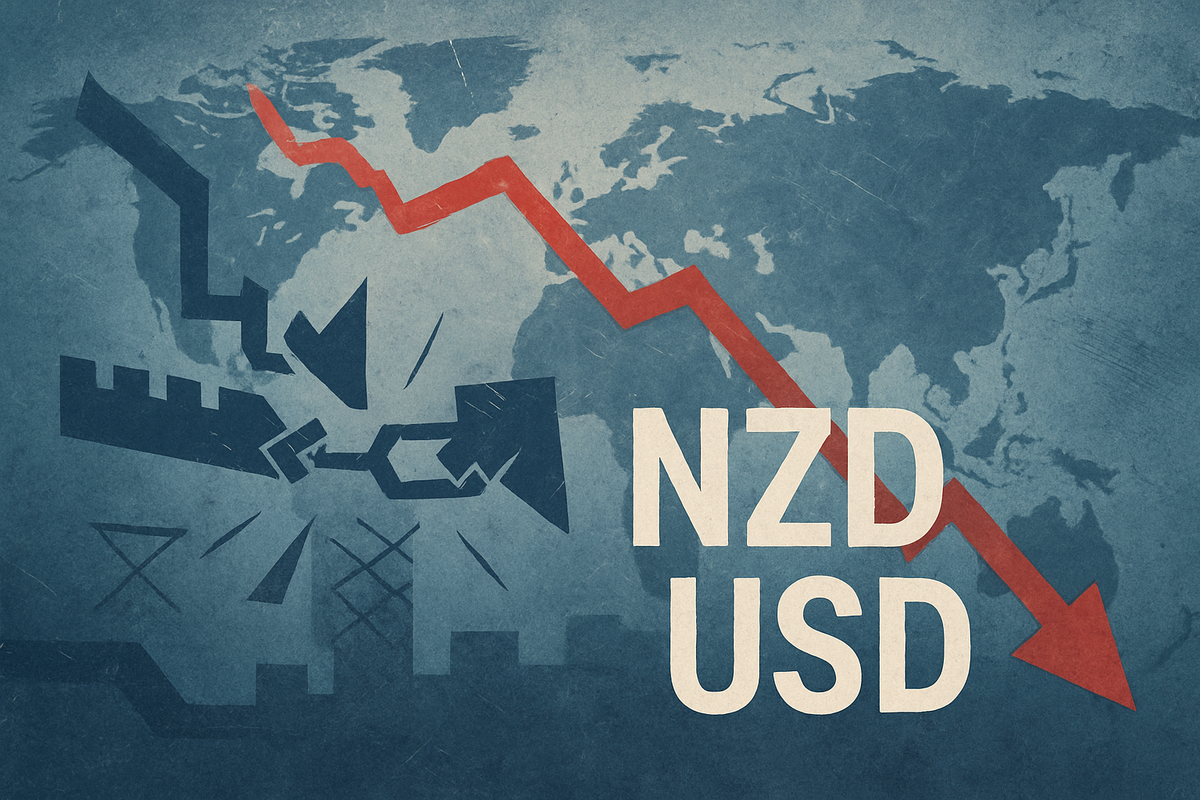Financial News
Global Trade Tensions Ignite Currency Volatility: NZD/USD Plunges Amidst Renewed Stress

A fresh wave of global trade protectionism and escalating currency volatility is sweeping across financial markets, with the New Zealand dollar (NZD) bearing the brunt of the storm. The NZD/USD pair has experienced a significant bearish slump, driven by a confluence of renewed US-China trade tensions, a dovish stance from the Reserve Bank of New Zealand (RBNZ), and a pervasive "risk-off" sentiment among investors. This downturn signals a troubling resurgence of economic uncertainty, prompting a flight to safe-haven assets and raising concerns about the stability of global supply chains.
The current market environment, as of October 2025, is characterized by fragile global growth and persistent geopolitical risks. The New Zealand dollar, a commodity-linked currency highly sensitive to global economic health, has weakened considerably, reflecting its vulnerability to trade disruptions and declining risk appetite. This trend is particularly interesting to investors as it highlights the increasing interconnectedness of global economies and the immediate impact of trade rhetoric on national currencies, forcing a reassessment of investment strategies in an increasingly unpredictable world.
Detailed Market Unrest: The NZD/USD Bearish Slump Unpacked
The recent bearish slump in the NZD/USD pair is a direct consequence of several intertwining factors that have intensified global trade stress and currency volatility. Specifically, the New Zealand dollar has been under significant pressure, weakening by over 4% in the past month and nearly 6% over the last 12 months against the US dollar. This decline has pushed the currency near a six-month low, approaching the 0.5700 handle.
The timeline of events leading to this moment is critical. The Reserve Bank of New Zealand (RBNZ) recently delivered an unexpected and substantial 50-basis-point rate cut in early October 2025, lowering its benchmark interest rate to 2.50%—the lowest in over two years. This dovish monetary policy stance, coupled with signals from policymakers that further easing is possible (with markets anticipating another rate reduction), has significantly eroded the NZD's yield advantage and made it less attractive to carry traders. Simultaneously, renewed US-China trade tensions have flared up, with US President Donald Trump reportedly threatening additional tariffs on Chinese goods, in retaliation for China's imposition of strict export controls on critical rare earth minerals. These protectionist measures have immediately triggered concerns about global economic fallout, disrupting supply chains, and amplifying financial turbulence.
Key players in this scenario include the RBNZ, whose aggressive rate cuts are aimed at stimulating domestic growth but inadvertently weaken the currency, and the US Federal Reserve, whose policy decisions on interest rates continue to influence the strength of the US dollar as a global safe haven. The governments of the United States and China are also central, as their trade negotiations and rhetoric directly dictate the level of global trade stress. Major commodity exporters, like New Zealand, are inherently exposed to these fluctuations. Initial market reactions have been swift and decisive: a broad "flight to safety" has seen investors divest from risk-sensitive assets, including the NZD, and flock to the US dollar. This has also put downward pressure on global commodity prices, further exacerbating the NZD's decline.
The immediate implications for the NZD/USD pair are a significant bearish slump driven by heightened risk aversion, a deterioration of New Zealand's trade balance due to reduced global demand for its exports, and an economic slowdown in key trading partners like China. The widening interest rate differential, with the RBNZ easing and the USD benefiting from safe-haven demand, further attracts capital away from New Zealand, contributing to the currency's weakness.
Corporate Fortunes Diverge: Exporters Gain, Importers and Tourism Suffer
The current environment of a depreciating New Zealand dollar and heightened global trade tensions is creating a stark divergence in fortunes for publicly traded companies with exposure to New Zealand's economy. Exporters with significant foreign currency revenues are poised to benefit, seeing their overseas earnings translate into greater NZD profits, while importers, tourism operators, and companies reliant on stable global supply chains face considerable headwinds.
Among the potential winners, Fisher & Paykel Healthcare Corporation Limited (NZX: FPH) stands out. As a major exporter of medical devices with a substantial portion of its revenue denominated in USD, a weaker NZD directly boosts its profitability when foreign earnings are converted back to its reporting currency. Similarly, agribusiness giants like Scales Corporation Limited (NZX: SCL), New Zealand's largest apple exporter, and Delegat Group Limited (NZX: DGL), a global wine exporter, are set to benefit from enhanced competitiveness of their products in international markets and increased NZD-denominated earnings. The a2 Milk Company Limited (NZX: ATM), specializing in A2 protein dairy products with significant Asian export markets, will find its products more affordable for international buyers, potentially boosting demand and profitability. Even Fonterra Shareholders' Fund (NZX: FSF), representing the global dairy powerhouse, is a primary beneficiary as a lower NZD boosts the value of its massive international dairy sales. PGG Wrightson Limited (NZX: PGW), while having a domestic focus, is intrinsically linked to the prosperity of the agricultural export sector, which thrives on a weaker currency.
Conversely, companies heavily reliant on imports, international tourism, or global trade volumes are likely to suffer. Auckland International Airport Limited (NZX: AIA), a critical gateway for international travel, faces a double blow: reduced international travel demand due to global economic malaise and trade stress, and potential decreases in air cargo volumes. Tourism Holdings Limited (NZX: THL), a premier tourism company, will also feel the pinch from potentially reduced international tourist arrivals, despite a weaker NZD making New Zealand a cheaper destination. Retailers such as Hallenstein Glasson Holdings Limited (NZX: HLG) and KMD Brands Limited (NZX: KMD) (operating brands like Kathmandu, Rip Curl, and Oboz) are vulnerable as a weaker NZD increases the cost of their imported inventory, squeezing profit margins and potentially impacting consumer discretionary spending. Global logistics and freight forwarding company Mainfreight Limited (NZX: MFT) will likely see its operations and profitability impacted by reduced trade volumes, tariffs, and supply chain disruptions. Even Fletcher Building Limited (NZX: FBU), while primarily domestic, could face reduced demand for construction materials in a severe global economic slowdown and higher input costs for imported materials due to the weaker NZD.
Some companies, like Scott Technology Limited (NZX: SCT), a robotics and automation company, present a more nuanced picture. While a weaker NZD benefits its export of automation systems, global trade stress could complicate international project execution and supply chains for components. Domestic telecommunications providers like Chorus Limited (NZX: CNU) and Spark New Zealand Limited (NZX: SPK) are relatively insulated from direct currency fluctuations on goods, but a significant domestic economic downturn could still impact spending, and a weaker NZD increases the cost of imported network equipment. This mixed bag underscores the complex interplay of currency movements, trade policy, and sector-specific vulnerabilities in the current market climate.
A Resurgence of Protectionism: Wider Implications for the Global Economy
The bearish slump in the NZD/USD and the broader increase in global trade stress are not isolated incidents but rather significant manifestations of a deepening trend towards deglobalization and protectionism that has been gaining momentum since the 2008 financial crisis and further accelerated by recent geopolitical events. This resurgence of economic nationalism, characterized by tariffs and trade barriers, fundamentally disrupts established supply chains, inflates costs, and fosters an environment of pervasive uncertainty that stifles business investment and economic planning on a global scale.
The ripple effects of this scenario extend far beyond New Zealand's borders, impacting key trading partners and global commodity markets. Australia, with its economy heavily reliant on open trade, particularly with major Asian partners like China, Japan, South Korea, is exceptionally vulnerable. A slowdown in China's economy, driven by US tariffs, would directly curtail demand for Australian exports such as iron ore, coal, and agricultural products, impacting its GDP growth. Across Asia, while some economies have proactively reduced their dependence on FX-denominated external debt since the Asian Financial Crisis, trade conflicts between major powers can still disrupt supply chains, force trade reorientation, and potentially lead to increased competition in global markets for targeted products.
Commodity markets are also highly sensitive to these dynamics. Gold typically shines as a safe-haven asset, with its prices surging during periods of intensified trade disputes and geopolitical instability. Crude oil and agricultural commodities exhibit more complex responses, often experiencing initial dips during trade war escalations but potentially rebounding as supply chains recalibrate. The fragmentation of commodity markets, driven by geopolitical tensions, poses a substantial risk, leading to large price changes and heightened volatility, which could have significant economic consequences for commodity-dependent economies and raise critical food security concerns for low-income countries.
Regulatory and policy bodies like the G20 and the International Monetary Fund (IMF) face renewed pressure to address this instability. The G20, in recent years, has shown a more divided stance on protectionism, with past communiques notably omitting explicit vows to resist all forms of protectionism. This suggests that coordinated international action to mitigate trade stress might be more challenging. The IMF, consistent with its mandate to promote global monetary cooperation, would likely advocate for structural reforms, financial liberalization, and multilateral cooperation to stabilize markets, drawing on its experience from past crises like the Asian Financial Crisis. They would also likely emphasize safeguarding global goals, such as "green corridors" for critical minerals and "food corridors" to prevent shortages.
Historically, the dangers of rampant protectionism are well-documented. The Great Depression of the 1930s serves as a stark reminder, where widespread trade barriers exacerbated and prolonged a global recession. More recently, the Asian Financial Crisis of 1997 demonstrated how currency volatility, originating in one nation, can rapidly spread across a region, triggering capital outflows and necessitating IMF interventions. The ongoing US-China Trade War, initiated in 2018, has already significantly disrupted global supply chains, increased business uncertainty, and contributed to a slowdown in global economic growth, reshaping global trade patterns and accelerating deglobalization trends that continue to influence economic dynamics in late 2025. These precedents underscore the potential for severe and lasting consequences if global trade stress and currency volatility are left unchecked.
Navigating the Storm: What Comes Next for Markets and Investors
The path forward for the NZD/USD pair and global trade dynamics is fraught with uncertainty, demanding strategic agility from both corporations and investors. In the short term, the New Zealand dollar is expected to remain under pressure, primarily due to the Reserve Bank of New Zealand's (RBNZ) dovish monetary policy. Analysts widely anticipate further rate cuts, potentially bringing the Official Cash Rate (OCR) to around 3.0% by the end of 2025. This contrasts with a potentially stronger US dollar, supported by a relatively robust US economy and the Federal Reserve's cautious approach to rate cuts, especially if inflation persists. Consequently, the NZD/USD could fluctuate between 0.5201 and 0.5413 by December 2025. Long-term projections for the NZD/USD are mixed, with some forecasts suggesting a continued decline towards 0.498 by the end of 2030, while others see a potential recovery towards 0.6179 by late 2027, contingent on global commodity market recovery and a significant weakening of the USD.
Global trade dynamics are expected to remain challenging, characterized by increasing fragmentation, protectionism, and geopolitical confrontations. The World Trade Organization (WTO) warns of a potential decline in global merchandise trade, exacerbated by new tariffs, supply chain disruptions (e.g., Panama Canal shortages, regional conflicts), and inflationary pressures. This environment fosters a trend towards regionalization and "nearshoring," as companies seek to build more agile and resilient supply chains closer to their core operations. The global economy is projected to experience modest growth of 2.5% in 2025, with inflation easing but potentially pushed higher by increased trade costs.
For corporations, strategic pivots are essential. This includes aggressively diversifying and building resilience into supply chains through nearshoring and multi-location manufacturing. Investing in digitalization and technology, particularly AI, is crucial for real-time insights and data-driven decision-making in managing fragmented supply chains. Geographic sales diversification, identifying new customer segments, and exploring alternative markets (like New Zealand's pivot to CPTPP, EU, and emerging markets) are vital to mitigate risks. Enhanced trade intelligence and compliance, alongside integrating sustainability into business models, will also be key for navigating evolving trade laws and forging new partnerships.
Investors must prioritize portfolio diversification and robust risk management strategies, including holding quality bonds, gold, and alternative assets. Opportunities may emerge in specific equities and sectors, with US and Japanese stocks considered attractive, alongside investments in AI infrastructure and megacap platform beneficiaries. Monitoring commodity prices, especially dairy, remains crucial for NZD-exposed portfolios. Currency strategies should focus on central bank policies and interest rate differentials. Furthermore, the rise of the Global South, particularly India and Southeast Asia, presents new trade avenues and investment opportunities in infrastructure, logistics, and technology as these regions enhance their manufacturing capabilities.
In a best-case scenario, a de-escalation of the US-China trade war, coupled with a more aggressive rate-cutting cycle from the Federal Reserve, could significantly weaken the USD. Simultaneously, New Zealand's agricultural exports could experience robust global demand, and the RBNZ might prove less dovish than expected due to unexpected economic resilience, providing underlying support for the NZD. Global trade could stabilize with reduced tariffs, fostering new trade agreements and regional integration, and AI adoption could drive significant productivity gains. Conversely, the worst-case scenario envisions an escalation of global trade wars, leading to further trade fragmentation and severe supply chain disruptions. The US dollar could strengthen substantially as a safe-haven, while the RBNZ is forced into deeper rate cuts due to persistent economic weakness and declining commodity prices. This could push the NZD/USD below key support levels, potentially towards 0.505876, with global growth forecasts revised significantly downwards, potentially leading to a recession driven by high inflation, high energy costs, and reduced confidence. The coming months will be a critical period for observing which of these scenarios begins to unfold.
Comprehensive Wrap-up: Navigating a Fractured Global Economy
The bearish slump of the NZD/USD in late 2025 serves as a potent barometer of a significant resurgence in global trade stress and currency volatility. This complex environment is predominantly shaped by renewed protectionist trade policies, particularly the escalating tensions between the United States and China, and the divergent monetary policy paths of central banks. The RBNZ's aggressive rate cuts, aimed at stimulating domestic growth amidst weak economic activity, have sharply contrasted with the US dollar's resilience, bolstered by its safe-haven status and potentially more robust economic performance.
Key takeaways from this period underscore that trade tensions are a primary driver of global market uncertainty, directly impacting currency valuations and the vulnerability of export-oriented economies like New Zealand. Monetary policy divergence, with the RBNZ easing while the USD remains strong, creates significant cross-currents in forex markets. The US dollar's enduring role as a safe-haven asset continues to attract capital during heightened global stress.
Looking ahead, the market is expected to remain highly volatile, with global real GDP growth projected to slow to around 2.9% in 2025 and 2026, exacerbated by trade policy shocks. The NZD is likely to remain under pressure, with limited upside unless the USD significantly weakens or global risk appetite materially improves. Trade outlooks are weakening, with the WTO forecasting only 0.5% growth in 2026 due to tariffs and uncertainty.
The lasting impact of this period could include persistently disrupted supply chains and inflationary pressures as tariffs increase costs. There's an elevated risk of economic slowdowns and even a global recession if trade tensions escalate further. This environment is also prompting a fundamental reassessment of investment flows, potentially shifting capital towards local assets in other regions and reducing foreign direct investment in emerging markets. Ultimately, the world appears to be moving towards a more fractured geoeconomic landscape, where trade relationships are increasingly dictated by geopolitical alliances rather than pure economic efficiency.
Investors should watch for several critical factors in the coming months. Foremost are US trade policy developments, particularly any further announcements regarding tariffs on China. Central bank communications from both the Federal Reserve and the RBNZ will be crucial for understanding shifts in interest rate expectations. Key economic indicators, including GDP growth, inflation reports, and employment data from major economies, will provide insights into underlying economic health. Geopolitical events and commodity price trends, especially dairy, will also significantly influence market sentiment and currency movements. By closely monitoring these dynamics, investors can better navigate the turbulent waters of a global economy grappling with renewed trade stress and currency volatility.
This content is intended for informational purposes only and is not financial advice
More News
View More




Recent Quotes
View More
Quotes delayed at least 20 minutes.
By accessing this page, you agree to the Privacy Policy and Terms Of Service.



